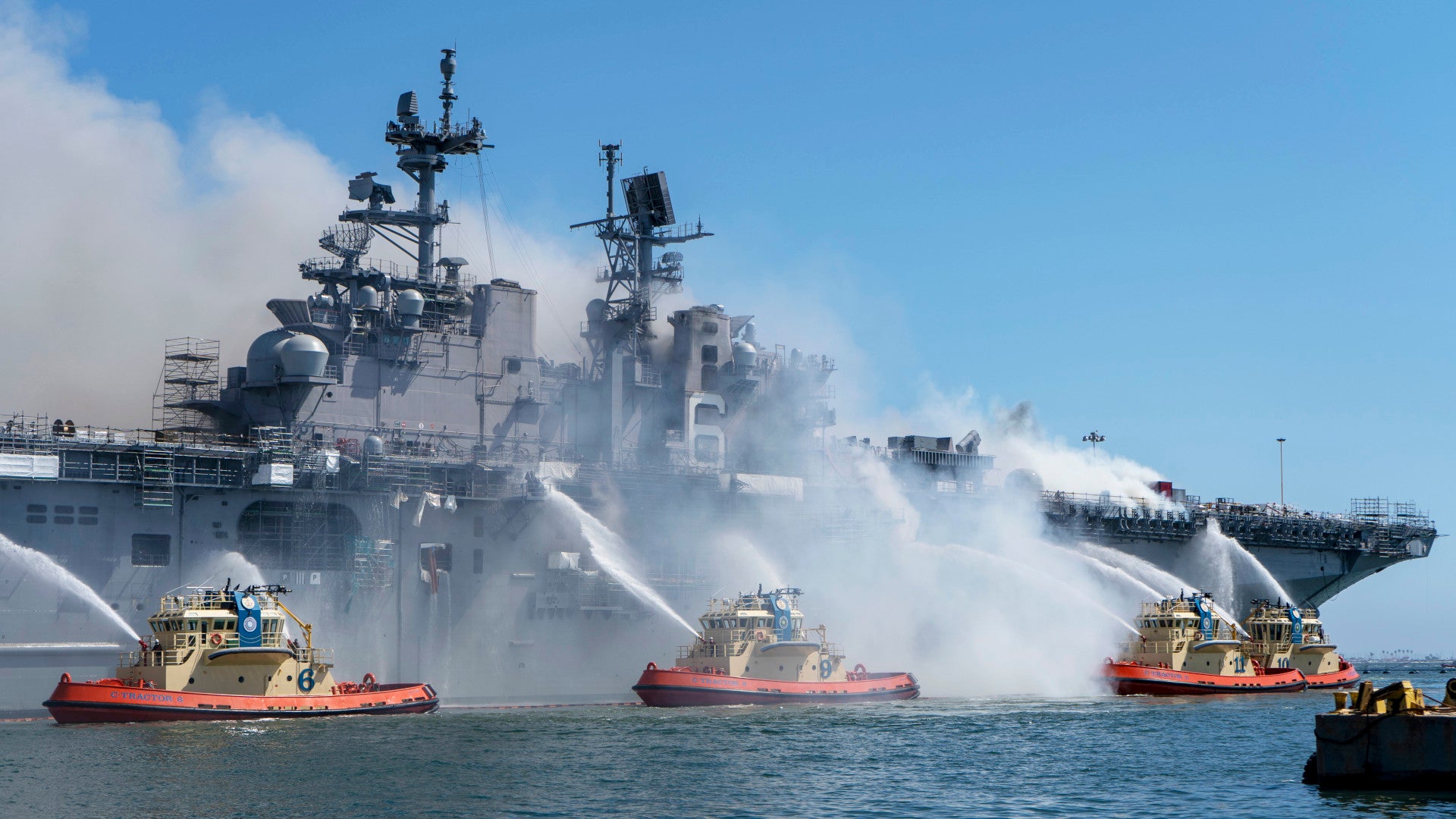The U.S. Navy has decided not to repair the Wasp class amphibious assault ship USS Bonhomme Richard, which burned for around four days following an explosion in July, suffering major damage as a result. The service decided that neither restoring it to its original configuration nor converting it to a different use were cost-effective options. Instead, it will spend approximately $30 million to scrap it.
The Navy made the announcement about the ship’s fate in a call with journalists on Nov. 30, 2020, more than four months after the fire was finally brought under control. An explosion on July 12 touched off multiple blazes that damaged some 60 percent of the ship, which was sitting pier-side in San Diego undergoing maintenance at the time. Over the course of the multi-day incident, 63 sailors and civilian firefighters were injured both as a result of the initial blast and the subsequent firefighting efforts. You can read more about what happened in TheWar Zone‘s reporting at the time.

The exact causes of the incident remain under investigation, but, in August, the service revealed that it was looking into the possibility of arson being a factor. Additional investigations are ongoing into how the ship’s design, as well the Navy chain of command, responded to the fire in order to glean information that could be used to improve safety systems, including fire suppression equipment, and protocols.
“After thorough consideration, the Secretary of the Navy and the Chief of Naval Operations have decided to decommission the Bonhomme Richard due to the extensive damage sustained during that July fire,” Navy Rear Admiral Eric Ver Hage, the head of the Navy Regional Maintenance Center and the Director of Surface Ship Maintenance and Modernization at Naval Sea Systems Command (NAVSEA), said. “In the weeks and months since that fire, the Navy conducted a comprehensive material assessment to determine the best path forward for that ship and our Navy.”
The Navy assessed that it would have cost between $2.5 and $3.2 billion to return Bonhomme Richard to its pre-fire configuration, a process that the service estimated would take between five and seven years to complete in a Gulf Coast shipyard. A less costly repair option that would have resulted in the vessel being reconfigured as a hospital ship or submarine tender would still have likely cost more than a billion dollars and taken five to seven years to complete, a greater expenditure of time and resources than buying an all-new ship for either of these roles.
Scrapping the ship will not be without its own costs. The Navy expects to spend around $30 million to break the Bonhomme Richard down, something that will take between nine months and a year to do. The service has already begun the process of salvaging any still usable systems from the remains of the amphibious assault ship, but will not be able to send it off to the shipbreakers until all the investigations are complete.

How the the loss of Bonhomme Richard will impact the Navy’s operations remains to be seen. The ship was one of eight Wasp class vessels, the service’s main type of amphibious assault ship. It also has two new America class amphibious assault ships, as well as a third, the future USS Bougainville, under construction. The Bougainville will be the first example of a distinct subclass, which you can read more about in this past War Zone piece.
In the meantime, the Navy will have to rely on the other seven Wasp class ships, which have the job of moving around Marine Expeditionary Units, sometimes with significant airpower in the form of large detachments of F-35B Joint Strike Fighters. These Amphibious Ready Groups regularly patrol or are otherwise prepositioned around the world, ready to respond to various crises and contingencies on short notice.
Admiral Ver Hage said that this reality was definitely taken into consideration when deciding to scrap Bonhomme Richard, but that there were other concerns about how the expenditure of time and resources to repair that ship might have impacted the Navy’s other shipbuilding priorities and other maintenance schedules. The service has been struggling for years now to address significant maintenance backlogs and expand available shipyard infrastructure.
“In the end, the decommissioning decision had a number of factors, and one of which was, what would be the impact of the dollars spent and the actual effort to rebuild, what would be the impact on the industrial base? The dollars definitely would disrupt our strategy for investment,” Ver Hage said. “And then from an industrial base perspective, we had concerns that it would impact new construction or other repair work, and we knew that Gulf Coast would be the spot to get the building or the restoration done because of the capacity and their capabilities – but in the end made the decision for multiple factors, as I mentioned, that decommissioning would be the way to go.”

This decision also notably comes as the Navy is pushing a proposed plan to reach a total fleet size of more than 500 ships by 2045, which could include a number of light aircraft carriers or amphibious assault ships in a similar role, topics The War Zone
has explored on multiple occasions in the past. It is also looking to move away from traditional large amphibious warfare ships toward smaller designs as the Marine Corps pursues its own dramatic overhaul of its force structure, which you can read about more in these past War Zone pieces.
All told, the Navy clearly came to the conclusion that sending Bonhomme Richard to meet the scrapper’s torch was the least bad option it had available.
Contact the author: joe@thedrive.com
